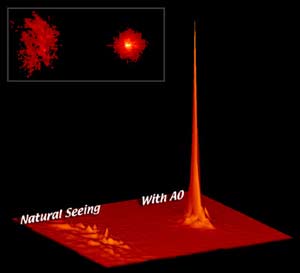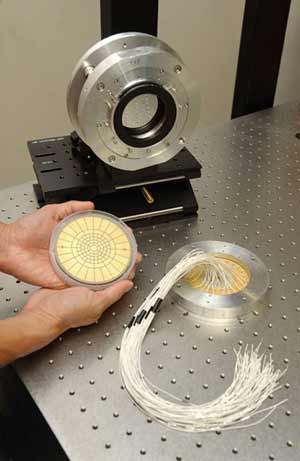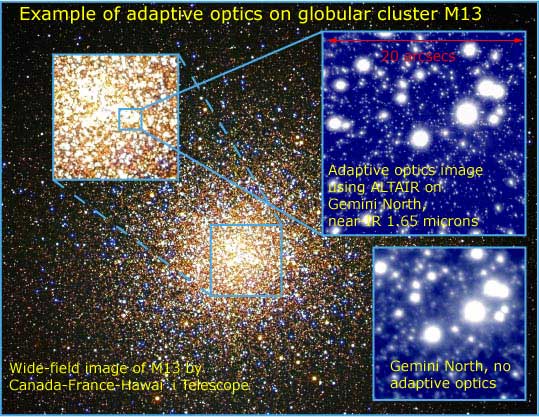Adaptive Optics
Relevant syllabus point:
- outline methods by which the resolution and/or sensitivity of ground-based systems can be improved, including:
- adaptive optics
What is Adaptive Optics?
As light from distant celestial objects enters our atmosphere it gets disturbed by our ever-moving atmosphere. Adaptive optics (AO) corrects for the distortions in an image caused by this atmospheric turbulence. The distortion to incoming light is shown schematically below.


What effect does atmospheric turbulence have on an image of a star? The image below shows how what should effectively be a point source from a distant star is smeared out due to turbulence. Adaptive optics compensates for this, resulting in a much sharper stellar image as seen on the right.
Adaptive optics systems operate at high frequencies, typically about 1000 Hz. This is too fast for altering a primary mirror so adaptive optic systems are designed to act via the secondary mirror and additional optical elements placed in the light path. The need for high speed computer calculations and special deformable mirrors means that AO is a relatively new field of development in astronomy. Rapid progress in developing the technology for telescope use occurred following the end of the Cold War when much of the military technology for AO systems was declassified.
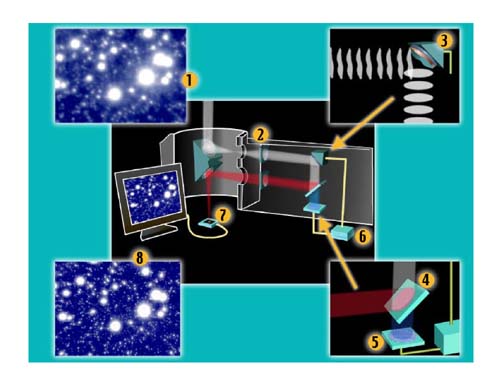
There are several different methods that can be used to monitor and correct the incoming wavefront of light but many use a tip-tilt mirror and a thin, deformable one. The one shown below is used on Gemini North and has 85 actuators on it to control the mirror shape.
Vital to all is the need for powerful, fast computer processing and modelling of the incoming waveforms. Systems either rely on a bright reference star within the field of view (which is surprisingly hard to find given the narrow field of view in many large telescopes) or they produce an artificial reference star using a laser.
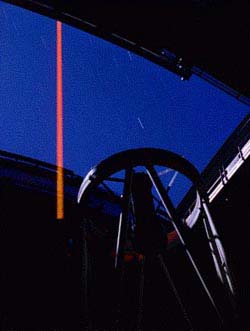
Australia is an active participant in the development of adaptive optic systems through the Research Network for Adaptive Optics. Apart from astronomy, adaptive optics also has applications in the fields of ophthalmology and vision science, optical communications, laser beam shaping and laser countermeasures.
At present, adaptive optics is still a new technology and many systems are in the developmental phase. Apart from the reference star problem, most systems also trade-off sensitivity for resolution as each additional optical element scatters some light and adds emits a small amount of heat, degrading infrared performance.
Whilst adaptive optics compensates for atmospheric distortions, the deformation of the large primary mirrors is corrected by active optics, as discussed on the next page.
Further Information
Adaptive Optics: What is it?@CfAO has a set of pages that describe what adaptive optics is, why we need it, how it works, its limitations and links to other AO resources. You can access printable versions of the pages. Part of the US Center for Adaptive Optics.
Adaptive Optics: Past, Present and Future is a set of slides on adaptive optics focusing on astronomical applications but also discussing others.
Adaptive Optics with Gemini provides a simple one-page introduction to the topic.
Research Network for Adaptive Optics is the homepage for Australian researchers involved in astronomical and other AO projects. Lots of information and links.
Sharper Eyes on the Sky by Dr John O'Byrne from University of Sydney is an online version of a 1996 article he wrote for Sky & Space Magazine. Although technology has developed since the article it still provides an excellent overview of resolution, seeing and adaptive optics.
The VLT Active Optics System has a clear diagram and a technical overview of the system.
Twinkle, twinkle little star: the need for adaptive optics in optical astronomy is a set of slides. The treatment gets very mathematical in places but the information is clear and accessible.
Questions
- What are some advantages in using an adaptive optics system on a telescope?
- Outline some limitations in implementing an AO system.
- Discuss some possible social benefits from research into AO systems.
- Why is it necessary for AO systems to work on the secondary or tertiary mirrors and not on the primary?

